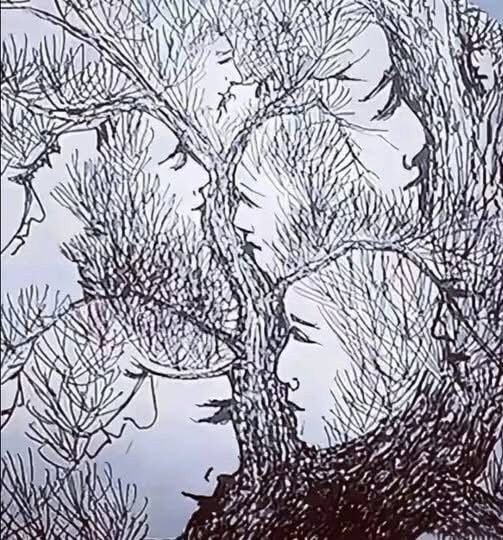Have you ever looked at a tree, a cloud, or even a burnt piece of toast and thought you saw a human face smiling back at you? If so, you’re not alone. That strange and wonderful moment when your mind turns random shapes into something recognizable has a name — pareidolia.
It’s a quirk of the human brain that transforms ordinary objects into something meaningful. Some people see faces in trees, others spot animals in clouds or figures in rock formations. What might seem like imagination is actually a fascinating glimpse into how our perception works — and why only a rare few can quickly spot every hidden face in an image.

The Science Behind Pareidolia
Pareidolia is the brain’s natural tendency to recognize familiar patterns — especially faces — in random or complex visuals. It’s a result of the brain’s pattern-recognition system, which evolved to help early humans detect predators, allies, and emotional cues instantly.
Our ancestors needed to react quickly to survive. Recognizing a face — even a false one — was far safer than missing a real one. Over thousands of years, that instinct became hardwired into our neural circuits.
Today, that same ancient system activates when you glance at a car’s front grille and see a “smiling face,” or when you look at a tree trunk and notice what appears to be an old man’s profile staring back at you.
Interestingly, scientists have found that pareidolia triggers the same regions of the brain that respond to real human faces — particularly the fusiform face area (FFA), which is responsible for facial recognition. That’s why these illusions feel emotionally real even when we know they’re not.

The Tree Illusion: Nature’s Hidden Canvas
One of the most popular examples of pareidolia today is the tree illusion — an image where faces appear to be carved naturally into the bark, branches, or roots. At first glance, it’s just a tree. But when you focus, human profiles start to appear: a pair of eyes, a nose, lips, even the outline of hair.
Artists and photographers have embraced this phenomenon, creating breathtaking “hidden face” artworks that challenge the brain to spot every subtle detail. These illusions are often shared online with captions like “Only 0.1% of people can find all the faces!” — and for good reason. They’re not just visually stunning; they’re psychologically engaging.
Some tree illusion artworks feature:
-
Lovers intertwined in the curves of the branches
-
Elders with wise expressions etched into the bark
-
Children laughing within the roots and lower leaves
-
Guardians or spirits peering from the hollow spaces
Each hidden face reveals itself slowly, rewarding patience and attention to detail — two qualities that keep viewers captivated. That’s exactly why these visual puzzles perform so well online: they hold attention, increase engagement, and spark conversations.

Why Artists and Designers Use Pareidolia
For digital creators, pareidolia isn’t just a curiosity — it’s a tool. Hidden-face illusions are often used in art, advertising, and web design to create deeper engagement. When viewers are challenged to “find all the faces,” they spend more time interacting with the image, which increases both emotional connection and page retention time — a gold metric for websites and AdSense publishers.
Artists also use pareidolia to bridge nature and imagination. By blending human forms into natural textures, they remind us that art doesn’t just imitate life — it’s part of it. These illusions turn ordinary trees, stones, or clouds into something deeply human, connecting us emotionally to the environment.
In fact, many neuroscientists believe that pareidolia is a creative act of the brain — a form of subconscious storytelling where the mind fills in gaps and creates meaning from chaos.
The Emotional Power of Hidden Faces
So why do these images affect us so deeply?
Because pareidolia isn’t just visual — it’s emotional.
When we recognize a face, even a false one, our brain releases subtle emotional signals associated with empathy, curiosity, and trust. Hidden-face art taps directly into that reaction, offering a sense of wonder and discovery.
Here’s how:
-
Curiosity: The hunt for hidden faces keeps our brains active and alert.
-
Imagination: Each discovered face feels like a secret revealed.
-
Relaxation: The slow observation process is similar to mindfulness — focusing attention in the present moment.
That’s why some psychologists recommend engaging with natural patterns — like finding faces in trees or clouds — as a form of visual meditation. It quiets analytical thinking and activates creative awareness.

What Pareidolia Reveals About You
The faces you see in these illusions can also say something about you.
Researchers suggest that pareidolia reflects personal mood, memories, or subconscious desires. For example:
-
Seeing a gentle or smiling face may indicate calmness or optimism.
-
Noticing a sad or angry face might reflect internal stress or empathy.
-
Finding multiple faces quickly shows strong visual perception and pattern sensitivity — a hallmark of creative thinkers.
In essence, when we look at a random object and “see” something familiar, we’re actually looking inward — our brains projecting fragments of ourselves onto the world around us.
Rediscovering the Hidden World
The next time you walk through a park or forest, take a closer look at the trees. Study their bark, the shadows between branches, the lines where roots twist into the soil. What might seem ordinary could reveal faces, animals, or even entire scenes hidden within the textures of nature.
You don’t need special equipment or imagination — just awareness.
This mindful observation not only enhances your appreciation for nature but also strengthens your brain’s ability to notice subtle details.
In a digital age dominated by screens, rediscovering the world through real-world pareidolia is a refreshing reminder: our surroundings are alive with stories waiting to be seen.

Pareidolia in the Digital Era
In recent years, pareidolia has gained viral popularity online — especially on platforms like TikTok, Instagram, and Reddit. Creators share optical illusions that challenge followers to “spot the hidden faces,” often accompanied by claims that only 0.1% can find them all.
While those numbers are mostly playful exaggerations, the viral appeal is real. These posts encourage interaction, spark debates, and inspire thousands to see everyday things differently.
Artificial intelligence has even joined the trend. Some AI art generators now intentionally design pareidolic imagery — blending human and natural forms to create mesmerizing illusions that blur the line between technology and psychology.
Conclusion: The Art of Seeing Beyond the Obvious
Pareidolia reminds us that perception is not just about seeing — it’s about connecting.
Our brains are storytellers, constantly weaving meaning from patterns, even in chaos. The faces we find in trees, clouds, and rocks reveal a simple truth: humans are hardwired to seek relationships, emotion, and beauty everywhere.
So, the next time you spot a mysterious face hidden in a tree trunk, don’t dismiss it as imagination. Instead, smile back. What you’re really seeing is the incredible power of your own mind — a masterpiece of perception shaped by millions of years of evolution.
